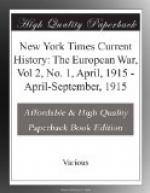Reinforcements have arrived from England with remarkable promptitude and rapidity. They have been speedily drafted into the ranks, and most of the units I inspected were nearly complete when I saw them. In appearance and quality the drafts sent out have exceeded my most sanguine expectations, and I consider the army in France is much indebted to the Adjutant General’s Department at the War Office for the efficient manner in which its requirements have been met in this most essential respect.
With regard to these inspections I may mention in particular the fine appearance presented by the Twenty-seventh and Twenty-eighth Divisions, composed principally of battalions which had come from India. Included in the former division was the Princess Patricia’s Royal Canadian Regiment. They are a magnificent set of men, and have since done excellent work in the trenches.
It was some three weeks after the events recorded in Paragraph 4 that I made my inspection of the Indian Corps, under Sir James Willcocks. The appearance they presented was most satisfactory and fully confirmed my opinion that the Indian troops only required rest and a little acclimatizing to bring out all their fine inherent fighting qualities.
I saw the whole of the Indian Cavalry Corps, under Lieut. Gen. Rimington, on a mounted parade soon after their arrival. They are a magnificent body of cavalry and will, I feel sure, give the best possible account of themselves when called upon.
In the meantime, at their own particular request, they have taken their turn in the trenches and performed most useful and valuable service.
11. The Right Rev. Bishop Taylor Smith, C.V.O., D.D., Chaplain General to the Forces, arrived at my headquarters on Jan. 6, on a tour of inspection throughout the command.
The Cardinal Archbishop of Westminster has also visited most of the Irish regiments at the front and the principal centres on the line of communications.
In a quiet and unostentatious manner the Chaplains of all denominations have worked with devotion and energy in their respective spheres.
The number with the forces in the field at the commencement of the war was comparatively small, but toward the end of last year the Rev. J.M. Simms, D.D., K.H.C., principal Chaplain, assisted by his secretary, the Rev. W. Drury, reorganized the branch and placed the spiritual welfare of the soldier on a more satisfactory footing. It is hoped that the further increase of personnel may be found possible.
I cannot speak too highly of the devoted manner in which all the Chaplains, whether with the troops in the trenches or in attendance on the sick and wounded in casualty clearing stations and hospitals on the line of communications, have worked throughout the campaign.
Since the commencement of hostilities the work of the Royal Army Medical Corps has been carried out with untiring zeal, skill, and devotion. Whether at the front under conditions such as obtained during the fighting on the Aisne, when casualties were heavy and accommodation for their reception had to be improvised, or on the line of communications, where an average of some 11,000 patients have been daily under treatment, the organization of the medical service has always been equal to the demands made upon it.




